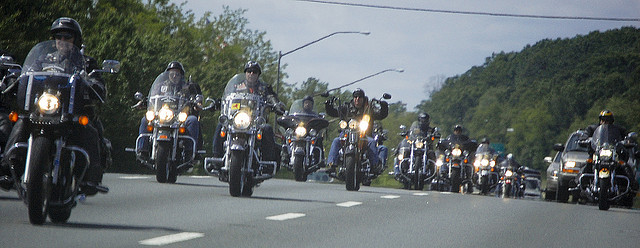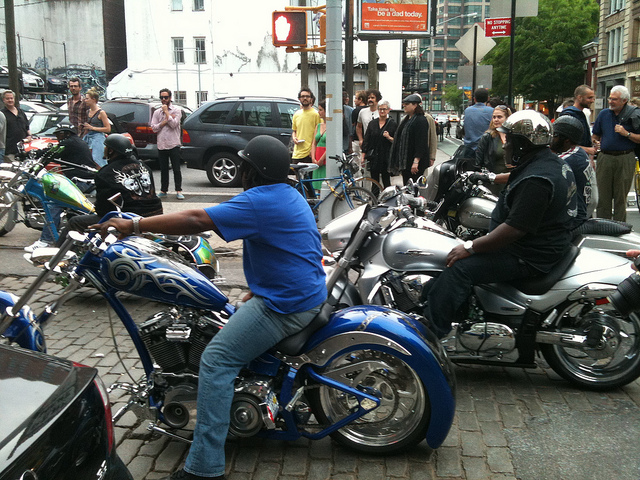How Biker Gangs Have Changed Over the Decades

By:
Most of us have seen what at least appeared to be a motorcycle gang. You're minding your own business at a diner or bar on the outskirts of town, and the rumble starts. Like a thunder storm on the street, dozens of heavy bikes and strange men descend on your location. Suddenly, you're surrounded. It's hard to know whether to be impressed or threatened.
ALSO: Teenager Fires Back at School After Being Sent Home
 Peachy Weasel / Flickr - flickr.com
Peachy Weasel / Flickr - flickr.com
“A man who has blown all his options can’t afford the luxury of changing his ways. He has to capitalize on whatever he has left, and he can’t afford to admit — no matter how often he’s reminded of it — that every day of his life takes him farther and farther down a blind alley,” reads a line from Hunter S. Thompson's 1966 book "Hell's Angels: A Strange and Terrible Saga." While there are many similarities in how motorcycle clubs operate in the United States since Thompson followed them around in the 1960s, much has changed, too.
An outlaw motorcycle gang is defined as: " A group of motorcycle owners who band together and who agree to disobey society’s laws." These gangs can be local, but they often span large areas, and many times smaller gangs will join larger ones to have access to their power and reputation.
There are many motorcycle gangs in the United States, but I'll stick to the big ones. While it's hard to nail down the exact membership numbers for these groups, we have some solid estimates from the Department of Justice. The Hells Angels are still very much around, with between 2,000 and 2,500 members, and they operate all over the country. The Mongols, mostly found in California, are believed to have around 1,500 members. The Bandidos in Texas, California, and beyond have around 2,500 members. The Vagos , a Mexican gang in the Southwest, is believed to have as many as 4,000 members.
Bike gangs the Bandidos and Cossacks made national news headlines after a shootout at a restaurant in Waco, Texas left nine people dead and 18 injured on May 17, 2015. At the time, police arrested 177 people, but not much was known about the insular groups, the Atlantic reports.
The changing landscape.
That may make it sound like these motorcycle gangs are large and thriving, but there's a serious debate about what's happening with motorcycle clubs in America. While gangs in Central and South America are pretty popular, and Northern Europe has some large gangs, American motorcycle gangs might be shrinking. "They've got an aging-out problem. Their numbers are getting older," James Quinn, a former University of North Texas professor who has studied motorcycle gangs, told ATTN:. "I think their numbers are getting smaller, but their activities are about the same as they have been for the last 10 or 15 years."
 Incase / Flickr - flickr.com
Incase / Flickr - flickr.com
Quinn explained that the gangs are still dealing in guns, drugs, and extortion, but much of the younger generation has ignored their presence. "Back in the 1960s and 70s, they really didn't want children in their groups," Quinn said. "By the 80s they [were] getting tolerant of it, and by the 90s they [were] encouraging members to raise children to be club members." Where a child might have hindered someone's ability to be part of the gang in the past, now it's seen as a possible opportunity for a legacy.
Another thing that's changed about motorcycle gangs, since they first started popping up in the 1940s and 1950s among the World War II veteran community, is that these gangs are no longer primarily men who don't have jobs and only make money illegally. Quinn said many gangs have moved from rural areas to bigger cities because the members are tied to somewhat successful jobs, like construction. This is one area where motorcycle gangs might differ from street gangs. "They're not going to take a complete loser, while a street gang very likely would," he said.
How they differ from street gangs.
Another way motorcycle gangs are different from street gangs is how people are admitted into the gang and how they operate. Motorcycle gangs "screen very heavily before they take people in as members, where as a street gang, you grew up down the street from them and maybe hang out with them some," Quinn explained. Motorcycle gangs are also typically regional, national, or international organizations, where most street gangs are local operations.
One area where street gangs and motorcycle gangs are very similar is in the fact that they're both almost always at war with someone. "Their loyalties are so deep, and they're so easily offended that it's not hard for somebody to stir up the gang loyalties," Quinn said.
Quinn believes the motorcycle gangs of today are often more reserved than the motorcycle gangs of the past. While the Department of Justice considers these gangs a significant threat, he said they don't seem to lash out and cause a scene as much as they used to. Motorcycle gangs are still alive and well in America, but they may be on a slow decline.
